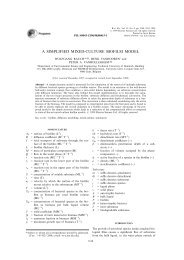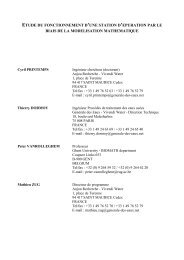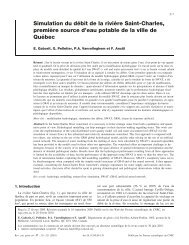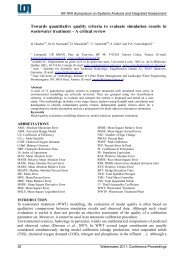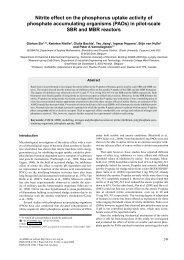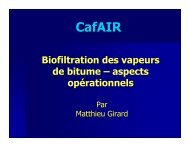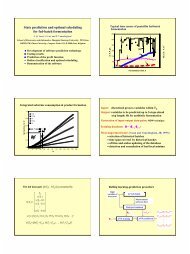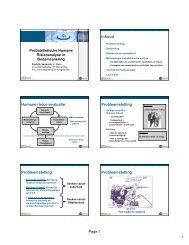Modeling 17α-ethinylestradiol removal in membrane bioreactors
Modeling 17α-ethinylestradiol removal in membrane bioreactors
Modeling 17α-ethinylestradiol removal in membrane bioreactors
Create successful ePaper yourself
Turn your PDF publications into a flip-book with our unique Google optimized e-Paper software.
Clouzot et al.<br />
the mass of carbon <strong>in</strong> pure biomass (C 5 H 7 O 2 N) of 0.53. The K D value obta<strong>in</strong>ed was 2.374 l/g,<br />
somewhat higher than what is found <strong>in</strong> literature. Calibration was performed on the sorption rate<br />
(k sor ), a value of 0.5 l/mg.d was applied <strong>in</strong> the model. Parameter values for the co-metabolic<br />
degradation of EE2 were calibrated <strong>in</strong> order to get the best fit dur<strong>in</strong>g phase 3 of the experiment.<br />
Table 4 shows all k<strong>in</strong>etic parameters used <strong>in</strong> the add-<strong>in</strong> model.<br />
Table 4. Calibrated values of the add-<strong>in</strong> model’s k<strong>in</strong>etic parameters.<br />
Parameters Calibrated values Units<br />
k sor 0.5 l/mg.d<br />
k des 210 d -1<br />
K EE2 0.00022 -<br />
n EE2 2 -<br />
k ACC 0.95 d -1<br />
η EE2,<strong>in</strong>i 9*10 -6 -<br />
η EE2,max 0.25 -<br />
K NEE2 0.6 mg/l<br />
The percentage of EE2 <strong>removal</strong> was measured dur<strong>in</strong>g the last 14 days of the MBR experiment<br />
(Figure 1). When EE2 was first added at a 20h-HRT, the <strong>removal</strong> gradually decreased from 100%<br />
to 90% over a period of three days. Sorption was characterized as the ma<strong>in</strong> <strong>removal</strong> mechanism<br />
(Clouzot et., 2010) and the model successfully described the experimental data for this phase.<br />
Figure 1. Experimental and modeled <strong>removal</strong> efficiencies of EE2 <strong>in</strong> the pilot-scale MBR.<br />
A simulation performed without the co-metabolism k<strong>in</strong>etic shows that long-term <strong>removal</strong> of EE2 by<br />
sorption stabilizes at 5%. This rather low value can be expla<strong>in</strong>ed by the long SRT applied to the<br />
model, which reta<strong>in</strong>s most of the sorbed EE2 and therefore saturates the sorption sites available <strong>in</strong><br />
the Hill k<strong>in</strong>etics, and by the high <strong>in</strong>fluent load of EE2 applied to the MBR.<br />
169



